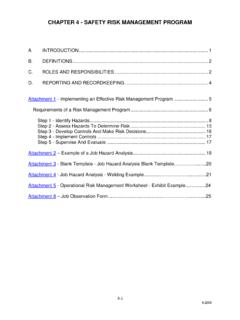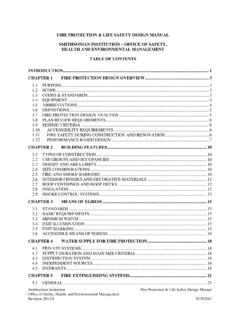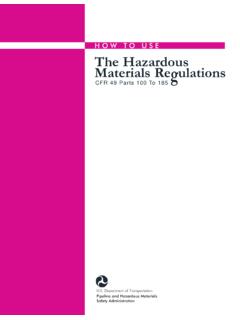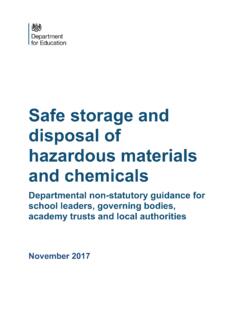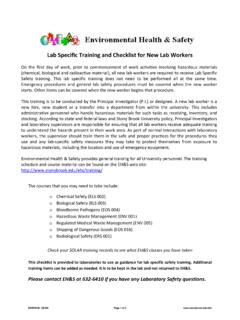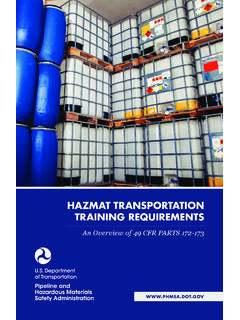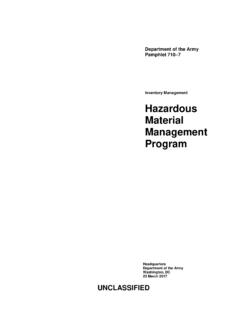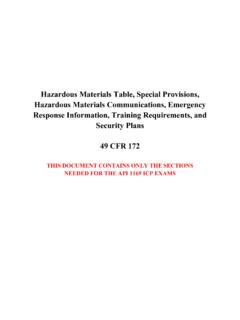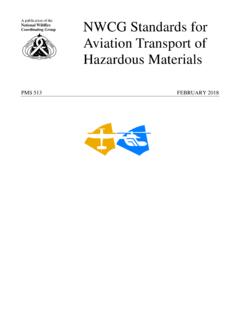Transcription of CHAPTER 13 MATERIALS HANDLING AND EQUIPMENT
1 13-i CHAPTER 13 MATERIALS HANDLING AND EQUIPMENT A. INTRODUCTION .. 1 B. CHAPTER SPECIFIC ROLES AND RESPONSIBILITIES .. 1 C. HAZARD IDENTIFICATION .. 2 D. HAZARD CONTROLS .. 3 E. TRAINING .. 14 F. REQUIRED INSPECTIONS .. 16 G. RECORDS AND REPORTS .. 17 H. REFERENCES .. 17 Attachment 1 Daily Forklift Checklist (Gas of LPG) .. 18 Attachment 2 Daily Forklift Checklist (Electric) .. 19 13-1 CHAPTER 13 MATERIALS HANDLING AND EQUIPMENT A. INTRODUCTION 1. This CHAPTER addresses the safety and health requirements for Smithsonian Institution (SI) MATERIALS HANDLING and storage and applies to all SI worksites.
2 All MATERIALS HANDLING and storage shall be performed in accordance with the requirements contained in the Occupational Safety and Health Administration (OSHA) standards in 29 CFR 1910 Subpart N, MATERIALS HANDLING and Storage, and the National Fire Protection Association (NFPA) Standard 505, Powered Industrial Trucks Type Designations, Areas of Use, Maintenance, and Operations. Since injuries may result from improperly HANDLING and storing MATERIALS , it is important to be aware of incidents that may occur from unsafe or improperly handled EQUIPMENT and improper work practices when HANDLING and storing MATERIALS .
3 Topics discussed in this CHAPTER include: a. Moving Loads (General) b. Loading Docks material HANDLING c. Manually Moving Loads d. Forklifts/Powered Industrial Trucks e. Hoists f. Scissor Lift Work Platforms g. Slings And Hooks h. Cranes And Gantries i. Other material HANDLING EQUIPMENT j. Storage Requirements (General) k. Storage Of hazardous MATERIALS /Chemicals (General) l. Storage Of Other MATERIALS 2. Refer to CHAPTER 19, Chemical HANDLING and Storage , of this Manual for detailed information on hazardous MATERIALS /chemicals HANDLING , use, and storage and CHAPTER 22, Compressed, Liquefied and Cryogenic Gases , of this Manual, for information on compressed gas HANDLING , use, and storage.
4 B. CHAPTER SPECIFIC ROLES AND RESPONSIBILITIES 1. Safety Coordinators shall: a. Assist supervisors in complying with this CHAPTER and ensuring that resources are available to fully comply. 13-2 b. Ensure retention of all employee EQUIPMENT training certificates. 2. Supervisors shall: a. Ensure hazard controls detailed in this CHAPTER are implemented. b. Develop Job Hazard Analyses per CHAPTER 4, Safety Risk Management Program , of this Manual for the more hazardous , non-routine material HANDLING operations.
5 C. Ensure employees receive training prior to operating and demonstrate they are competent to operate material HANDLING EQUIPMENT . d. Allow employees to only operate material HANDLING EQUIPMENT for which they have been trained; e. Ensure employees follow all safety requirements and perform safely. f. Ensure employees have and use personal protective EQUIPMENT to include safety shoes and hard hats when moving objects that are overhead and goggles when moving liquids that could pose a splash hazard.
6 3. Employees shall: a. Perform material HANDLING operations and operate material HANDLING EQUIPMENT safely to prevent injury or damage; b. Inspect and perform safety checks on material HANDLING EQUIPMENT before each use to ensure EQUIPMENT is in proper working order and is appropriate for material being handled; c. Report any deficiencies found during pre-use inspections to supervisor; d. Not operate material HANDLING EQUIPMENT for which they have not been trained. e. Follow all safety requirements, use required personal protective EQUIPMENT and perform their duties safely.
7 C. HAZARD IDENTIFICATION 1. Back injury is the number one injury associated with improper material HANDLING . 2. Heavy or unbalanced loads could fall and injure employees, especially head and feet. 3. Vehicle becomes unbalanced and overturns with driver not wearing seat belts. 4. Improper or unsafe use of material HANDLING EQUIPMENT could cause injury or property damage. 5. Falls from working platforms or ladders could occur (refer to CHAPTER 10, Fall Protection , of this Manual). 13-3 6.
8 Damaged or poorly maintained EQUIPMENT could cause injury. 7. Battery charging and filling pose significant risks (refer to CHAPTER 19, Chemical HANDLING and Storage , of this Manual). 8. Loading docks pose numerous risks for injury or property damage to include: a. falls from unguarded dock edges, b. slips/trips due to wet or icy surfaces, c. caught between/under due to crowded staging areas, unbalanced loads, d. collision due to numerous pieces of moving EQUIPMENT or vehicles, e. tip over due to steep inclines improperly traversed, f.
9 Lift platforms could fail or operate improperly, g. Wheeled vehicles could roll if not properly secured, or damage to vehicles could occur due to tight maneuver room, h. Overhead doors may open or close unexpectedly, i. hazardous chemicals with their commensurate risks may be involved during loading/unloading operations (refer to CHAPTER 19, Chemical HANDLING and Storage , of this Manual). j. Any fuel-operated material - HANDLING vehicle poses the risk of fire and explosion. k. material HANDLING EQUIPMENT used in cramped spaces or populated areas pose significant hazards of injury or property damage.
10 D. HAZARD CONTROLS 1. Moving Loads (General) a. Check the load first to decide how best to move it forklift, hand truck, hoist, conveyor, manually, etc. Then check the route to be taken and remove obstacles, or find another route if the obstacle cannot be moved. Make sure there is space for the load at its destination and that EQUIPMENT , platforms, elevators, etc. are rated to handle the load weight and bulk. b. Forklifts, hand trucks, dollies, or other material HANDLING EQUIPMENT (MHE) carrying unbalanced loads or loads that obstruct the operator s view may be dangerous to the operator and any other employees in the area.
